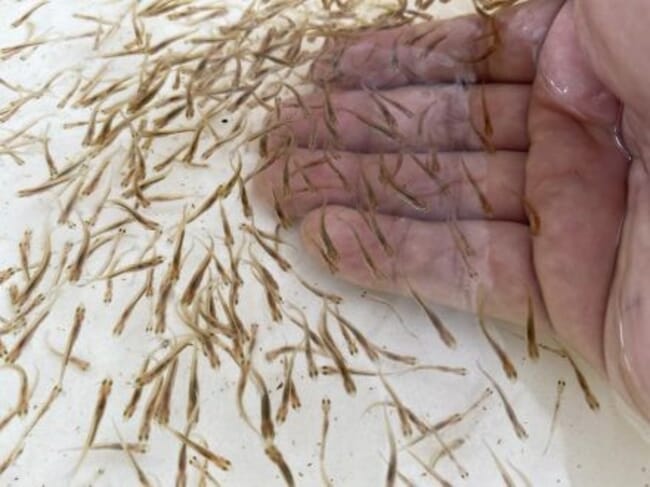
Milkfish fry at the hatchery of the Southeast Asian Fisheries Development Center, Aquaculture Department in Tigbauan, Iloilo that are ready to be transported to nurseries and grow-out farms © JF Aldon
“The shortage of milkfish seeds is more pronounced in the Philippines between November and February when the weather becomes too cold for breeders to lay eggs,” said SEAFDEC chief Dan Baliao. “Thermal manipulation is necessary to help milkfish hatcheries stay productive during the four-month off-season by ensuring a continuous supply of seed.”
In order to induce broodstock to spawn, SEAFDEC scientists installed water heaters in a 500-tonne tank housing over 100 milkfish, raising the temperature to at least 29 °C from November to February.
Data from the SEAFDEC/AQD hatchery show that milkfish (which are commonly referred to as bangus in the Philippines) normally only spawn between March and October when the weather, and consequently the water, is warmer. From November to February, the hatchery was essentially unproductive due to lower water temperature.
Using thermal manipulation in the research centre’s demonstration facility, SEAFDEC/AQD collected about 2.9 million good eggs, from which almost 1.7 million normal larvae were hatched in a time that is normally considered off-season by milkfish hatcheries.
Dir Remia Aparri of the Department of Agriculture’s Bureau of Fisheries and Aquatic Resources (DA-BFAR) Region 6 expressed her support to the technology which she said will contribute to fish sufficiency of the country.
“With available milkfish fry all throughout the year, this will encourage bangus growers in fishpond and mariculture areas to increase their capacity to produce more thereby contributing to increasing milkfish production,” Aparri said.
Although designated as the unofficial national fish of the country, about half of the 400,000 metric tonnes of milkfish served on Filipino dining tables each year are actually produced in hatcheries in Indonesia and Taiwan before being imported for grow-out in the Philippines.
Baliao added that due to the heated breeder tank, SEAFDEC/AQD was able to donate 1.1 million milkfish larvae to a satellite hatchery in Batan, Aklan that is being rehabilitated in collaboration with DA-BFAR.
Previously a hatchery that produced shrimp fry, the facility is being revived jointly by SEAFDEC/AQD and DA-BFAR to boost the local supply of seeds as part of the latter’s Bangus Fry Sufficiency Program.
DA-BFAR estimates an additional 1.2 billion locally-produced fry are needed every year on top of 1.1 billion current local production. This brings national requirement to 2.5 billion as the expansion of local production is expected to reduce importation by 85 percent.
To further expand local production, SEAFDEC/AQD is nearing the completion of a new milkfish broodstock facility and a new milkfish hatchery, both set to be inaugurated in April 2021.
Baliao also added that SEAFDEC/AQD is willing to assist hatchery operators who plan to incorporate thermal manipulation in their facilities.
SEAFDEC/AQD and DA-BFAR are also working towards the establishment of legislated multi-species hatcheries alongside the repair and rehabilitation of abandoned hatcheries around the country. Upon completion, each of these hatcheries are projected to produce 25 million fry every year.


